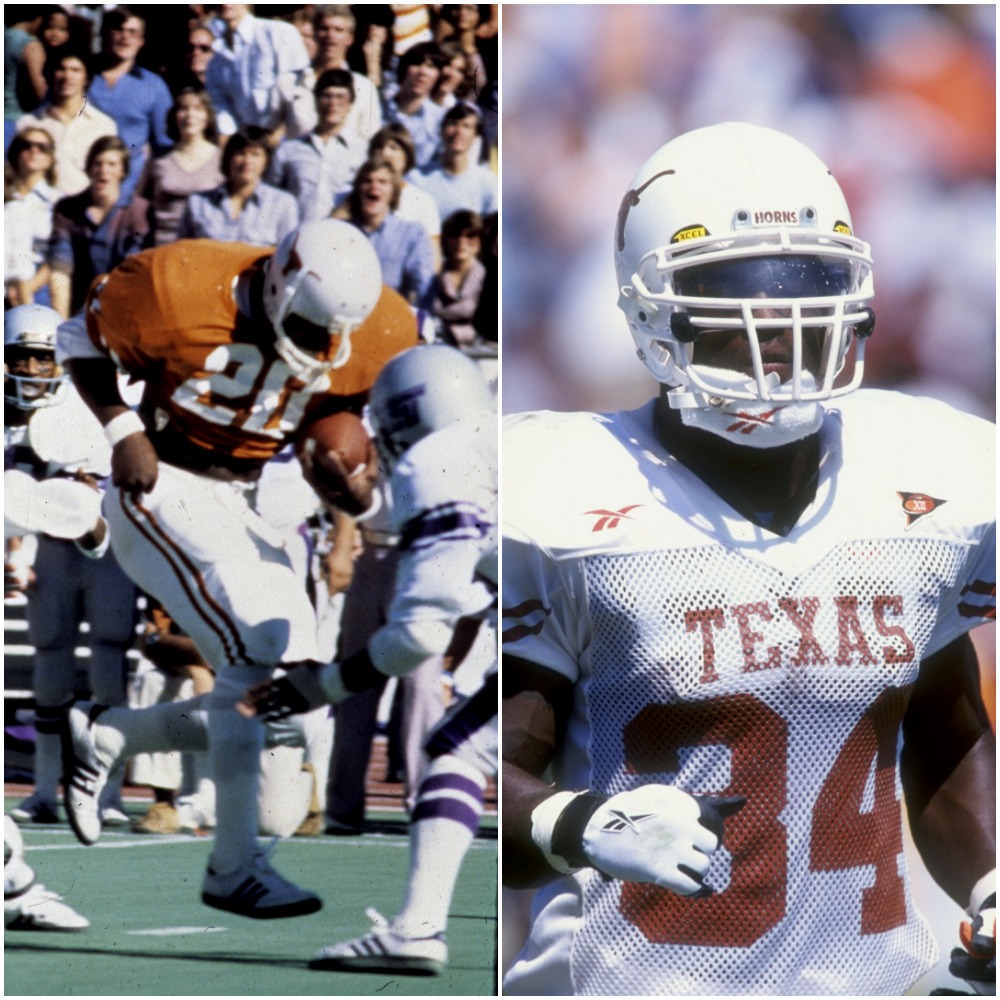NCAA
Texas Longhorn Legends Ricky Williams and Earl Campbell Forever Remembered on Field Where They Made Their Names

When you mention the Texas Longhorns to any college football fan, two players generally come to mind — Earl Campbell and Ricky Williams. There’s a reason. Campbell and Williams were the two best Longhorns to ever play at the University of Texas and they have the Heisman Trophies to prove it.
Now, the College Football Hall of Famers will have something more than their statues on display at the Forty Acres. The two running backs will forever be honored at the newly named Campbell-Williams Field. The renaming of the field was a part of sweeping changes the university made in response to players requesting the school remove its racist symbolism and replace it with prominent black figures in Longhorn history.
Earl Campbell wins first Heisman for Texas Longhorns
RELATED: What Happened to Hall of Fame Running Back Earl Campbell and What Is His Net Worth?
Former Oklahoma head coach Barry Switzer once said when Earl Campbell arrived at the University of Texas, he was good enough to play in the NFL. You would be hard-pressed to find any defensive players who tackled Campbell during his time at Texas or in the NFL that would disagree.
With the Longhorns, Campbell was a dominant force his entire career. He scored six touchdowns and rushed for 928 yards on 162 carries, a whopping 5.7 yards per carry his freshman year. Campbell bookmarked his time in Austin with a senior year where he rushed for 1,744 yards en route to winning the first Heisman Trophy in Texas football history.
Campbell went on to have a very successful NFL career with the Houston Oilers and New Orleans Saints. In each of his first three seasons in Houston, he received All-Pro and Pro Bowl honors, and was named the NFL’s Offensive Player of the Year. He played one season in New Orleans before he retired in 1985 and finished his career rushing for 9,407 yards and 74 touchdowns. He was inducted into the College Football Hall of Fame in 1990 and the Pro Football Hall of Fame in 1991.
Ricky Williams sets rushing record with Texas Longhorns
RELATED: Ricky Williams Was at the Heart of the Worst NFL Draft-Day Trade We’ve Ever Seen
Ever since Earl Campbell’s Heisman Trophy season in 1977, Texas Longhorns fans yearned for another running back that could dominate. It finally happened 18 years later when Ricky Williams arrived on campus.
The California kid joined the Longhorns in 1995 and established himself his freshman year rushing for 1,052 yards. Each year Williams improved on his numbers from the year before and by the time he reached his senior season, many thought Williams had a shot at breaking the career all-time rushing record held by Tony Dorsett.
Williams did just that for the Texas Longhorns in 1998 when he rushed for an impressive 2,327 yards and passed Dorsett in the process. After he won the Heisman Trophy that season, Mike Ditka made the controversial move to trade all of the Saints’ draft picks in the 1999 NFL draft so the team could move up and draft Williams.
Williams played from 1999 to 2011 in the NFL with two missed seasons — one a result of a retirement and another a violation of the league’s substance abuse policy. He earned All-Pro and Pro Bowl honors in 2002 when he led the league in rushing with 1,853 yards. He finished his NFL career just eclipsing the 10,000-yard mark. Williams was inducted into the College Football Hall of Fame in 2015.
University renames field Campbell-Williams Field
RELATED: Texas Football Player Vows Not to Play Another Snap Until He Sees Change in America
In mid-June, after using social media and marching in protest against racial injustice, the Texas Longhorns football team was joined by other sports including basketball, and volleyball, in making a unified statement that demanded the university make multiple changes throughout the campus and its institutions.
This week the university announced a set of diversity initiatives that included “reconsidering how to best reflect the university’s values, both in the symbols and names on campus and in the openness with which UT tells its history.” While the “Eyes of Texas” fight song will remain, one of the biggest changes was renaming the football field.
The university agreed to change the name of the field from Joe Jamail Field to Campbell-Williams Field. Jamail was a lawyer and a significant benefactor to the university. The university also announced it would erect a statue of Julius Whittier, the first black football player to letter at Texas in 1970.
While the new field name honors the legacy of the two greatest players to ever set foot on the field, more importantly, it is a positive step for the university in reflecting the school’s history and its student body more accurately.











